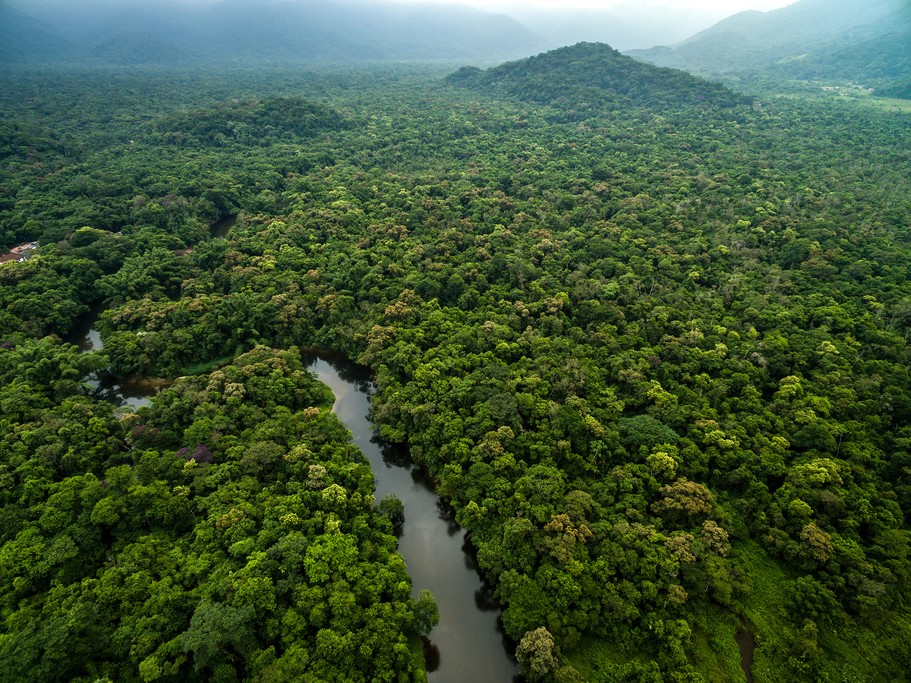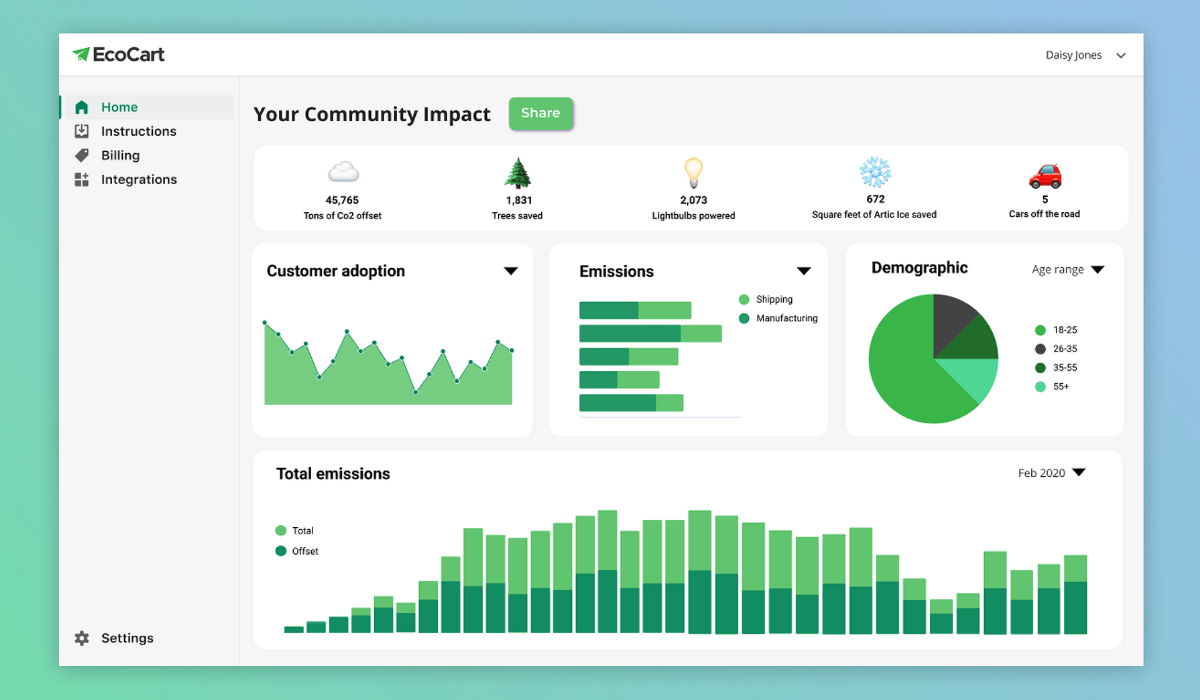Carbon offsets allow companies to balance out their carbon emissions by investing in projects that avoid or remove greenhouse gasses elsewhere. This guide provides a comprehensive look into the process, from the creation and verification of carbon offsets to their conversion into carbon credits.
What Are Carbon Offsets?
Carbon offsets are a form of trade that allows individuals and companies to compensate for their carbon emissions by investing in environmental projects that remove or avoid greenhouse gas emissions elsewhere. Theoretically, they offer a way to balance out carbon footprints where emissions produced by business operations cannot easily be reduced.
By investing in carbon offsets, ecommerce businesses can not only mitigate their environmental impact but also enhance their brand’s reputation among increasingly eco-conscious consumers. This investment demonstrates a commitment to corporate social responsibility, potentially attracting a broader customer base.
Want to know where your business stands? Get your sustainability scorecard with our quiz:
How carbon offsets are created
Carbon offsets are created by a range of entities, including non-profit organizations, for-profit companies, and sometimes government bodies, who develop offset projects specifically designed to either remove greenhouse gasses from the atmosphere or avoid new emissions. Here’s a breakdown of how each type of offset project works:
Removal Projects directly capture and store greenhouse gasses from the atmosphere. Examples of carbon removal projects include:
- Reforestation and Afforestation: Planting new trees to absorb CO2.
- Carbon Capture and Storage (CCS): Capturing CO2 emissions from industrial processes and storing them underground.
- Biochar: Converting organic materials into a stable form of carbon, which is then stored in soil, preventing its release into the atmosphere.
- Soil Carbon Sequestration: Adopting agricultural practices that enhance soil’s natural ability to store carbon, such as no-till farming and the use of cover crops.

Avoidance Projects prevent emissions from being released into the atmosphere. Examples include:
- Renewable Energy: Generating electricity using renewable sources like wind or solar, instead of fossil fuels.
- Methane Capture: Capturing methane emissions from landfills or livestock before they are released, preventing their contribution to the greenhouse effect.
- Energy Efficiency: Implementing more efficient technologies and practices in buildings, transportation, and industry to reduce overall energy consumption and emissions.
- Forest Conservation: Protecting existing forests from deforestation, preserving the carbon stored in trees and soil.
Both types of projects contribute to the fight against climate change but do so through different mechanisms—either by directly removing CO2 already in the atmosphere or by preventing future emissions.
How carbon offsets are verified
In the carbon offset market, the lack of a unified global standard and centralized marketplace creates a complex environment for businesses seeking to invest in carbon credits. This complexity arises from a diverse landscape of standards, registries, verifiers, brokers, and rating agencies, each playing a crucial role but with overlapping functions.
This is why working with trusted providers that adhere to reputable carbon standards and undergo regular verification processes is crucial.
EcoCart’s carbon offsetting projects, for example, undergo lab and field testing with third-party verification and site visits to accurately calculate the amount of greenhouse gas emissions being offset. Our carbon offsetting projects must be registered by one of the following carbon offset standards:
- Climate Action Reserve (CAR)
- Verra’s Voluntary Carbon Standard (VCS)
- American Carbon Registry (ACR)
- Gold Standard (IGS)
- Plan Vivo
Why Carbon Offsetting Matters For Ecommerce Businesses
Carbon offsetting is crucial for ecommerce businesses due to several key reasons:
- Consumer Demand: Increasingly, consumers prefer to shop from environmentally responsible brands. Demonstrating a commitment to sustainability through carbon offsetting can enhance brand loyalty and attract eco-conscious customers.
- Competitive Advantage: Ecommerce businesses that offset their carbon footprint can differentiate themselves in a crowded market, turning their environmental efforts into a unique selling point.
- Regulatory Compliance: With growing global emphasis on climate action, carbon offsetting prepares businesses for future regulations and standards aimed at reducing corporate carbon emissions.
- Corporate Responsibility: Beyond compliance and marketing, carbon offsetting aligns with a broader corporate responsibility to mitigate climate change impacts, contributing positively to the global community and environment.
- Operational Efficiency: The process of assessing and offsetting emissions often identifies areas for operational improvements, leading to cost savings and increased efficiency over time.
Download our FREE ebook:

Carbon Offsets And Credits
Carbon offsets become carbon credits through a clear, step-by-step process. First, the emissions avoided or removed by a project are carefully measured. These figures are then checked by independent experts to confirm their accuracy and ensure they meet certain environmental standards, like the Verified Carbon Standard. Once verified, which we already outlined just above, each tonne of CO2 reduced or removed is turned into a carbon credit.
After verification, carbon credits are registered on an official carbon registry, turning them into a purchasable asset. This registry serves like an online marketplace, where these credits are listed for sale. It offers a simple way for businesses or individuals to buy credits, helping them offset their emissions easily. This registration ensures everything is transparent and accessible, making it easier for anyone to support global efforts to mitigate emissions.
Coming up, we’ll dive into what makes a carbon credit “good” and how the buying and selling process works in the carbon market.
What is a high-quality carbon credit?
A high-quality carbon credit represents a genuine, measurable avoidance or removal of carbon dioxide from the atmosphere. Understanding the characteristics of such credits is important for both ensuring that your carbon offset credit is legit and that it actually helps combat global warming. Here’s a breakdown of the key factors that define a high-quality carbon offset credit:
- Additionality: The project must result in carbon reductions that wouldn’t have occurred without it. For example, a wind farm built in a location that otherwise would have relied on coal power.
- Quantification: The amount of CO2 reduced or removed needs to be accurately measured. An example is using standardized methods to calculate the carbon captured by a new reforestation project.
- Leakage: This refers to unintended emissions elsewhere as a result of the project. A high-quality credit ensures minimal leakage, such as a forestry project that doesn’t lead to deforestation in nearby areas.
- Permanence Risk: The project’s benefits should last over time. For instance, a reforestation project should have safeguards against future deforestation.
- Vintage: This term refers to the year the carbon reduction occurred. Recent vintages, such as credits generated in the past year, often indicate more immediate impacts.
- Co-benefits: High-quality credits also support additional environmental or social benefits, like biodiversity conservation in a reforestation project or improved air quality and job creation from a renewable energy project.
Each of these points ensures that a carbon credit not only contributes to reducing emissions but also supports broader environmental and social goals, enhancing its overall value and impact.
The carbon offset marketplace
Carbon credits are a tradable commodity produced by carbon offset projects, then sold on the carbon market. These credits represent the removal of one metric tonne of greenhouse gas (GHG) emissions or the equivalent (tCO2e) in other GHGs, such as methane or nitrous oxide.
The carbon offset marketplace comprises two main segments: the compliance and the voluntary markets.
- The compliance offset market is regulated by government policies, requiring companies to offset a portion of their emissions as part of legal obligations.
- The voluntary offset market allows businesses and individuals to purchase carbon offsets on their own initiative, aiming to reduce their carbon footprint and contribute to environmental sustainability.
Can businesses purchase carbon offsets?
Yes, businesses can purchase carbon offsets to mitigate their carbon footprint. In the voluntary market, platforms like EcoCart provide an accessible way for ecommerce businesses to offset their emissions. EcoCart offers a checkout widget that enables customers to offset the carbon footprint of their purchases at the point of sale. The offsets connected through EcoCart’s widget are sourced from projects verified by VERRA, ensuring credibility and real environmental impact.

Can individuals purchase carbon offsets?
Yes, most definitely. In the voluntary carbon offset market, individuals can purchase carbon credits to offset their own greenhouse gas emissions from everyday activities such as driving a car or flying on a plane. Use tools like the Environmental Protection Agency’s (EPA) Carbon Footprint Calculator or Terrapass to estimate your personal or household emissions based on travel, energy use, and other factors. Then you can buy carbon offsets from trusted platforms like Terrapass, for lifestyle emissions; Gold Standard, for projects with additional community benefits; or Cool Effect, which provides transparent funding for carbon reduction projects. By doing so, individuals take action to reduce their carbon footprint and play a vital role in combating climate change and contributing to a more sustainable future.
Conclusion
Ready to take action against climate change? EcoCart’s suite of tools, including the checkout widget, Life Cycle Assessment (LCA) capabilities, and the sustainability insights dashboard, empowers ecommerce businesses to take definitive steps toward achieving green certifications.

The Life Cycle Assessment (LCA) provides detailed insights into your products’ environmental impacts, guiding you toward more sustainable practices. Where you cannot eliminate emissions, our checkout widget effortlessly integrates carbon offsetting into your online store, allowing customers to offset their purchases. And with the sustainability insights dashboard, monitor your progress and share your achievements toward climate neutrality. Contact us to request a demo today.



